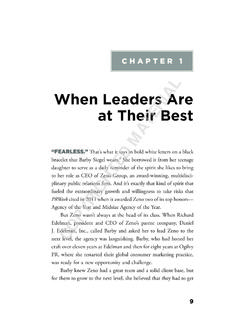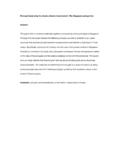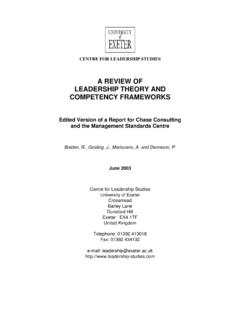Transcription of LEADERSHIP AND INNOVATION: CHAMPIONS AND …
1 LEADERSHIP and innovation 1 LEADERSHIP AND innovation : CHAMPIONS AND TECHIES AS AGENTS OF INFLUENCE C. B. Crawford, Institute of LEADERSHIP Studies Fort Hays State University Hays KS 67601 (785) 628-4303 A Paper Presented to the Association of LEADERSHIP Educators 2001 Conference Review CommitteeLeadership and innovation 2 ABSTRACT The effects of innovation on LEADERSHIP abilities have not been widely investigated. Although diffusion of innovation theory has existed for some time, there is a need for other perspectives. In two (N=238, N=294) related studies it was found that innovation , LEADERSHIP , and influence were related, though specific relationship indicated tendencies toward certain styles of influence.
2 innovation was significantly related to transformational LEADERSHIP abilities. Implications emerging from the relationship between transformational LEADERSHIP and innovation are discussed, including the distinction between the champion and "techie" styles of innovation and their basis in LEADERSHIP activity LEADERSHIP and innovation 3 INTRODUCTION Computerization has changed the way people do their jobs and, even the way people look at work (Kling & Dunlop, 1993). Technological changes have had a major effect on how business is done and on the managerial utilization of communication. Today s organization is different in structure and function due to the integration of new technology. This study explores the process of innovation as an act of LEADERSHIP , and the subsequent influence required.
3 Diffusion of innovation Communication interfaces have grown faster to meet the needs of communication systems and the growing number of people interested in networking. New technology is different because of the integration of programmable machinery (Sproull & Goodman, 1990). The challenge is the useful harnessing of technology by individuals within a social context for beneficial outcomes (Biocca, 1993). Giacquinta, Bauer, and Levin (1993) indicated that whatever technology is used for, "the attitudes and activities that people need to adopt " (p. 134) are critical elements for innovation to occur. The social component shapes how technology is used; people use new technology in ways that mirror existing purposes. innovation is planned, executed, and evaluated by people. It is also social, since people rarely adopt without others adopting. Research about innovation assumes that technological innovation occurs within a social context.
4 innovation is also a natural process; those not adopting technology are in the minority. Technological innovation is studied with a positive bias; progress is positive and reluctance to innovate stops progress. innovation is universally good (Van de Ven, 1986). The "technological fix" implies technology can solve all social problems. The drive for technology is the fulfillment of a need (Van de Ven, 1986). Rogers (1983) suggests that innovation is a communication process about something newer or better. innovation , like communication, is not a one-way linear event. innovation is relational and dynamic. He defined a range of personal behaviors toward innovation based on a bell-shaped curve. Behavioral categories range from an innovator (at the highly innovative end) to a laggard (at the low innovation end). Rogers (1986) explained that diffusion is the process that communicates an innovation over time among members of a social system.
5 Thus, diffusion of innovation is both a social and individual activity. He theorized that a small number of people innovate very quickly. Next, a substantial number of individuals are early adopters. Early adopters precede the early majority who adopts a little before others in their social network. The next group, on the other side of the mean, is late adopters. Late adopters are still ahead of the final classification, the laggard. Laggards are not interested in integrating new technology. Rogers' theory helps define the range of personal behaviors in relation to innovation . His model is an appropriate foundation for empirical study and gives further basis for the quantification of personal innovativeness. innovation and the Modern Organization Morton (1991) suggested that the marketplace of the 1990s is a turbulent business environment impacted by information technology integration. Information LEADERSHIP and innovation 4 technology is changing the way that work is done, integrating business functions at all levels within and between organizations, causing shifts in the competitive climate in many industries.
6 Cushman and King (1993) stated that the integration of new manufacturing, marketing, and management information technologies contributed to the emergence of the global organization. The high-speed management wave, which began in the high-tech sector, has spread outward. Hiemstra (1983) suggested that information technology was the central issue for all organizations. Carroll and Prein (1994) noted that computer integration has both positive and negative consequences. Information technology allowed organizations to reassess their missions and operations, change management and organizational structure, and challenge LEADERSHIP to transform organizations for the future (Morton, 1991). Markus, Bikson, El-Shinnawy, and Soe (1992) indicated that media usage differs by workgroup, people want integration of communication technologies and integration may not lead to seamless collaborative work. Schein (1994a) claimed that information technology impacts the organization s culture and LEADERSHIP .
7 Furthermore, the culture impacts the structure and processes of the organization, which influence innovation . innovation is partially mediated by the external constraints on technology. Allen and Hauptman (1994) posited that functional organization is replaced with project organization (teaming). If technology is manageable, people work together for a short time and if there is high interdependence, then project teaming is preferable to functional organizing. Communication and innovation play interdependent roles and communicative coordination should take place in functional or project organizations. Flexible hierarchies will allow organizations to react and adapt. Loveman (1994) suggested that overall productivity has not climbed due to expenditures on information technologies, but the future should yield more efficient use of information technology and a boost in productivity. Social changes occur when technology is introduced.
8 Employees that were more successful at integrating new technology interacted more frequently, were more communicatively competent, and had better listening abilities (Papa & Tracy, 1988). People who champion innovation tend to be risk takers, use more influence, use a greater variety of influence methods, and they have higher levels of transformational LEADERSHIP behaviors (Howell & Higgins (1990a). Crowston and Malone (1994) examined personal effects from the introduction of new technology. Increased information technology effects the content and quantity of communication patterns. Individuals using electronic communication channels have lower status differentials than people not using electronic media; using electronic communication media helps remove the occupational role identity and helps people communicate as equals. Recent research on innovation and influence indicated that innovators used no more team or charismatic influence methods than moderate or laggard adopters (Crawford & Strohkirch, 1996; 1997).)
9 Innovators did have a higher preference for the use of reward/punishment/ manipulation influence methods. Historically, innovation research focused more on the process of adoption as the phenomenon of interest. More recent research has been centered on the social implications of innovation . Research from authors like Walther (1994), Howell and Higgins (1990a, 1990b, 1990c), and Rice (1987) suggests that the act of innovating has LEADERSHIP and innovation 5 definite social implications in the personal, organizational, and global context. Given the current social influence direction of modern LEADERSHIP , it seems reasonable that innovation may be related to transformational LEADERSHIP qualities. Transformational LEADERSHIP The original formulation of transformational LEADERSHIP theory comes from Burns (1978).
10 At the core of transformational LEADERSHIP is the concept of transformation, or change of the organization. Tichy and Devanna (1986a) noted that companies were being asked to make fundamental changes. Transformational LEADERSHIP best reflects this change (Bass, 1985). Burns (1978) defined transformational LEADERSHIP as a process in which "leaders and followers raise one another to higher levels of morality and motivation" (p. 20). A chief element of transformation is the ability to cultivate the needs of the follower in a follower centered (person-centered) manner. According to Burns, focusing on needs makes leaders accountable to the follower. First, Burns contended that followers are driven by a moral need, the need to champion a cause, or the need to take a higher moral stance on an issue. People like to feel that a higher organizational spiritual mission guides their motives. The second need is a paradoxical drive for consistency and conflict.











